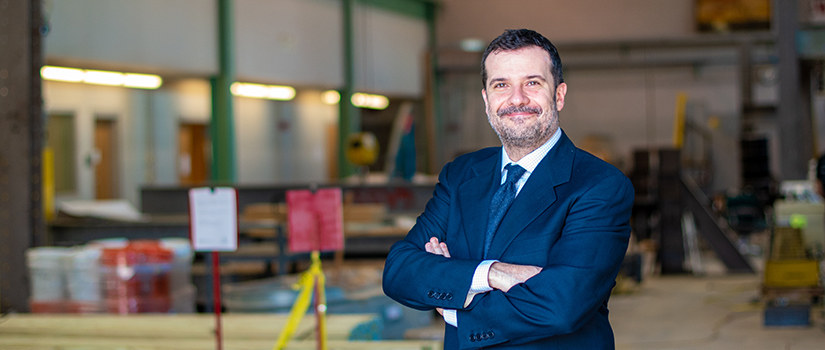UofSC and SRNL research could strengthen coastal structures and nuclear waste containment infrastructure
Fabio Matta, an associate professor of civil and environmental engineering in the College of Engineering and Computing, is working to improve concrete durability using extremely small amounts of graphene oxide nanoribbons (GONRs) in collaboration with the Savannah River National Laboratory (SRNL).
Matta believes that this process can help make concrete tougher and more durable, for example preventing cracking and mitigating degradation phenomena such as corrosion, and reducing surface loss and damage caused by abrasion and loads. The concrete’s increased durability through GONR reinforcement would also ultimately reduce its cost since structures will have a longer lifespan and require less cementitious material and maintenance. As a result, the energy and carbon dioxide emissions involved in concrete manufacturing would be offset.
Matta and Shohana Iffat, a Ph.D. student, are collaborating with Jay Gaillard, a principal engineer at the Savannah River National Laboratory, and Mohammed Baalousha, an associate professor in the Arnold School of Public Health, on this exploratory research, which is nearing completion.
“Put simply, we are embedding extremely small amounts of specially designed nanoparticles, which you can only see with a powerful microscope, in concrete materials to modify their composition and microstructure," says Matta. "By doing so, we can simultaneously change different properties that play important roles in enhancing durability, such as porosity, strength, stiffness, toughness and abrasion resistance.
"For example, by changing porosity and toughness, we can make it much more difficult for concrete to progressively crack and create pathways for aggressive chemicals to get in, such as deicing salt solutions that lead to corrosion of the internal steel reinforcement. Or prevent leaching, if we use similarly engineered materials to store and trap nuclear waste. And we’re working to do so with minimal changes in cost, which is critical.”
Matta, Gaillard and Baalousha started their collaboration through seed funding provided by UofSC’s Advanced Support for Innovative Research Excellence (ASPIRE) grant program, and continued their work with support from SRNL’s Laboratory Directed Research and Development. Through SRNL’s capabilities, they are modifying carbon nanotubes by unzipping them and creating nanoribbon particles (GONR) that combine the length of nanotubes with the chemically active surface of graphene nanoplates, carbon materials—nanotubes and nanoplates—that have been shown to hold promise to enhance concrete when added in small amounts. These characteristics are such that GONR particles may work more efficiently with cement particles as they hydrate and harden to form concrete, thus allowing to further push the envelope toward reducing the amount of nanoparticles needed.
Gaillard says, “One of the things we envision is being able to reduce the amount of concrete needed to build structural elements such as a slab, a wall or a containment vessel. We can reduce the thickness because it’s stronger, tougher and more durable. It also allows us to reduce the energy involved in manufacturing. Because concrete is the second most widely used substance in the world, second to water, and accounts for up to eight percent of the world’s carbon dioxide emissions, this is significant.”
The team envisions a number of possible applications for GONR-reinforced concrete. One is large-scale construction projects that are sensitive to environmental degradation, such as in coastal areas where salt atmosphere has a significant impact on concrete. Another application is nuclear power and nuclear waste infrastructure, which in some instances consists of dry storage casks made of a layer of steel surrounded by a thick layer of concrete.
“There is a wide range of very different applications with a common need of enhanced durability so that systems can keep working for long periods of time,” Matta says.
Matta explains that the study is currently in the proof-of-concept prototyping and testing phase, which will help researchers understand the GONR material properties and prepare them for incorporation into actual concrete. First the team must ensure nanoparticles aren’t agglomerating when dispersed in water. Thereafter, the water with the GONR is added to the concrete mixture following standard practices. Once combined, all the particles must properly distribute throughout the mixture to create a durable system, a concept the team already verified with carbon nanotubes and graphene nanoplates.
Matta says, “This area has gained a lot of interest in the past 10-15 years, but there is very little research on actual concrete. Researchers began by studying basic properties of different parts of concrete material such as cement paste, which is an important piece of the puzzle, but far from complete and relevant in practice. Moving past the necessary delays due to COVID-19, we’re now close to gaining evidence of performance for actual concrete, and we’ll keep looking for opportunities to advance this research.”
Mohammed Baalousha is an associate professor of environmental nanoscience in the Arnold School of Public Health. He conducts laboratory and field research on the environmental fate, implications and applications of engineered nanomaterials.
Fabio Matta is an associate professor of civil and environmental engineering in the College of Engineering and Computing. He conducts experimental and theoretical research on construction materials and their structural performance, from affordable and high-quality earth masonry to advanced cement- and polymer-matrix composites, with an emphasis on extreme stressors.
